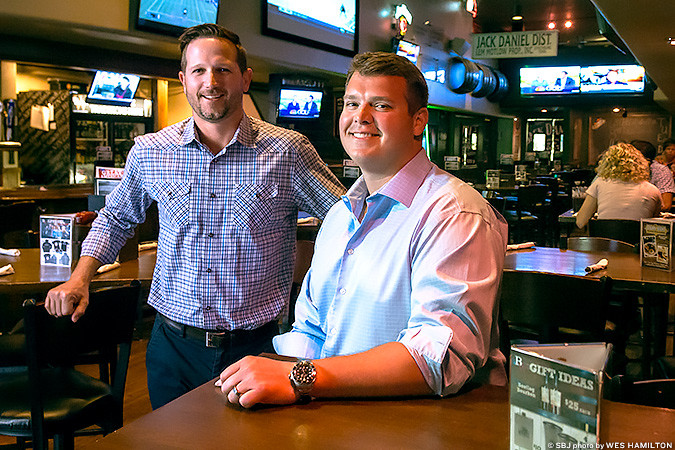What started downtown has grown to a Springfield-area restaurant chain with aspirations for regional and national placement.
Ten years ago, Big Whiskey’s LLC opened its first restaurant on Park Central East with a simple mantra of serving Americana-style food and drinks in a tavern setting.
Today, the group comprising Paul Sundy, Austin Herschend, Michael Heslin, Randy Gildehaus and Jame Clark has loftier goals in mind.
The owners run three Big Whiskey’s American Restaurant & Bar operations in Springfield, and one each in Ozark and Branson. The second restaurant they opened – in Little Rock, Ark. – is now operated under separate ownership through a licensing agreement.
In 2015, the five restaurants under Big Whiskey’s LLC generated $9.4 million in revenue, a 43 percent increase from 2014. Profitability is growing as well, the owners say, with EBITDA in double digits percentages at all stores.
With last year’s opening on Branson Landing inside Hilton Promenade, revenue came closer to $10 million for the 12 months ended May 31. Branson is now poised as the largest revenue store, largely due to tourism, with the 1515 E. Battlefield Road store in close second.
“Branson has absolutely killed it for us,” Sundy says from his downtown office sandwiched between Big Whiskey’s and another of his restaurants, Dublin’s Pass.
Also in May, the company celebrated its first year serving over 1 million guests.
“That’s a lot of butts in seats,” Herschend says.
They’re looking to capitalize, and franchising is what’s next.
“That’s a whole new ballgame,” Sundy says. “Our product is our store.”
Beyond Missouri
In 2014, the partners launched Big Whiskey’s Franchising LLC and a year later gave the CEO title to co-owner Herschend of the Herschend Family Entertainment Corp. family.
The group signed its first franchisee, real estate broker Shane Miller, earlier this year to open a store in Bentonville, Ark., in the heart of the booming northwest Arkansas metropolitan area that recently crossed the 500,000 population mark. The store, near the headquarters of Wal-Mart Stores Inc., is targeted to open late in the year or early 2017.
Two months later, in April, the company announced plans to enter the Kansas City market with two restaurants, one a franchise and one a corporate store.
The franchise deal is with H2B Restaurants LLC, an entity owned by local certified public accountants Ed House and Ryan Bohl, as well as J.D. House, who lives in the Kansas City area.
Herschend says the Houses grew up in Kansas City and also own the Eagle Stop chain of convenience stores throughout the state. The relationship with Ed House gave the guys of Big Whiskey’s an opportunity, as well.
“We’re seeing rewards from seeding the market,” Herschend says.
Both Kansas City stores are slated to open around the same time in early 2017, and site selection is underway. The owners would like to continue putting corporate stores in franchise markets.
“Every great corporate franchisor, I believe, still has corporate stores because they’re still on the hunt,” Sundy says, pointing to Springfield-based Andy’s Frozen Custard’s franchising model as an admirable solution.
National aid
Sundy says the company’s early franchising goal calls for 10 restaurants, but he wants to take that number to the triple digits. Big Whiskey’s can legally operate in 36 states.
The franchising process required Sundy, Herschend and crew to rethink the concept, particularly what it means for a restaurant to be called Big Whiskey’s.
“We’re not a sports bar. We’re a restaurant that likes sports,” Sundy says of the self-identification process, also pointing to Big Whiskey’s as an establishment that serves drinks but is not a true bar. “People are tired of the same corporate America feel, like Applebee’s. They want something true.”
For help, they enlisted The iFranchise Group Inc., a national consulting firm based out of Chicago with clients including Denny’s, McAlister’s Deli and T-Mobile.
The idea was to take what they already knew to be working about Big Whiskey’s and put it on paper so each franchisee would know how to emulate the company’s style, quality of food, such as burgers, wings and steaks, and drinks, of which the company requires a minimum of 80 whiskeys.
“How do we position this to go nationwide?” Sundy says of the need for consulting. “They helped us get the ball rolling.”
It turns out they weren’t too far off.
Of up to 500 inquires the company receives a month, The iFranchise Group typically selects three to take on as clients. Unlike other companies they’ve worked with, iFranchise Group CEO Mark Siebert says Big Whiskey’s already was operationally sound.
“They’ve taken the trouble to do things right,” he says, noting they’ve made investments in franchisees, particularly a thorough franchise disclosure document. “These guys have dotted every I, crossed every T.”
Big Whiskeys owners decline to talk investment in the franchise model.
For franchisees, the projected initial investment range for a single startup restaurant is between $528,500 and $1 million, including a franchise fee of $50,000, according to
BigWhiskeysFranchise.com. Franchisees agree to pay annual royalties of 5 percent of gross revenue. They also are required to spend at least 2 percent of gross revenue on local marketing and contribute up to 1 percent of gross revenue into a marketing fund, which serves all stores.
“Big Whiskey’s is a company that really has its act together,” Siebert says. “Not every business can be franchised. Most of them don’t have an idea what it’s going to take.”
The company now has “red-hot leads” in Houston and Dallas, Texas, as well as in Alabama, though they’ve received calls from as far away as Florida, Sundy says.
“It’s location, location, location,” he says. “That hasn’t changed, ever.”
